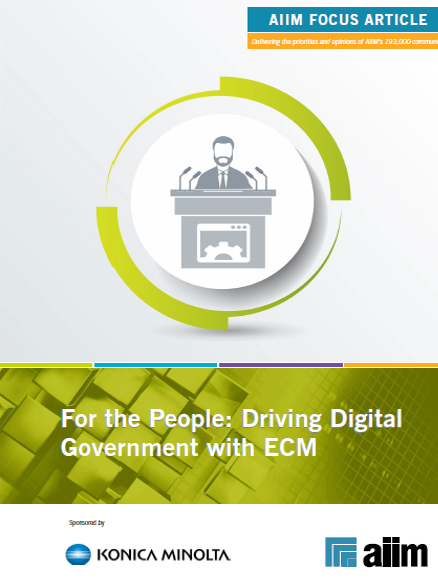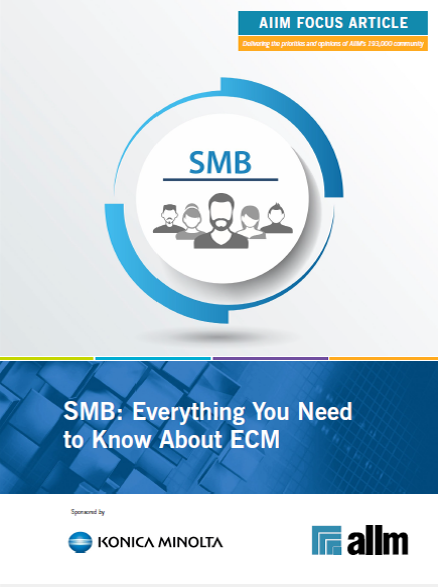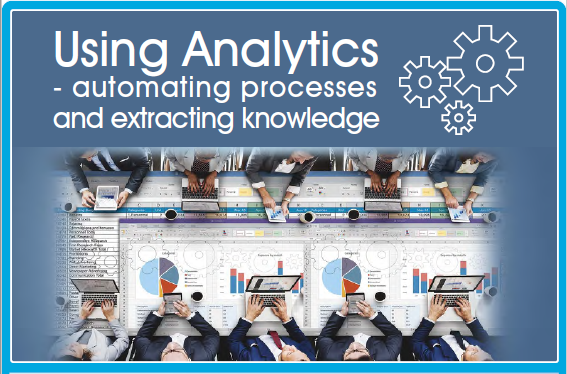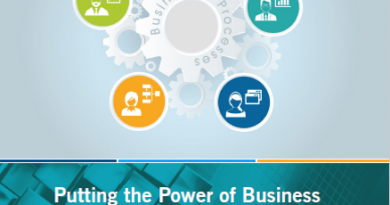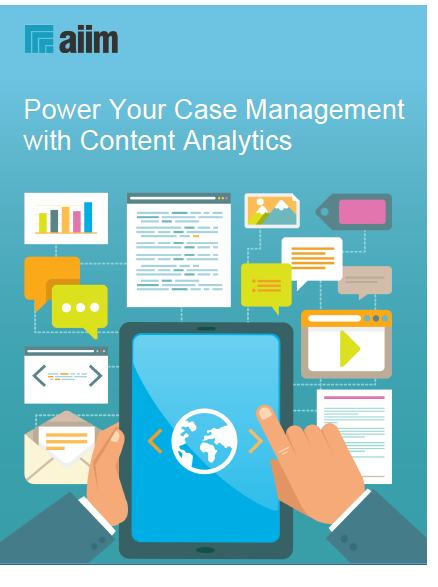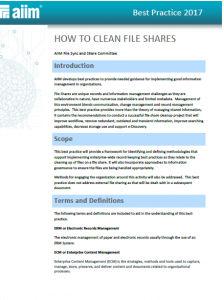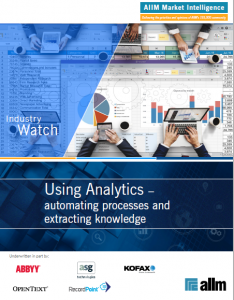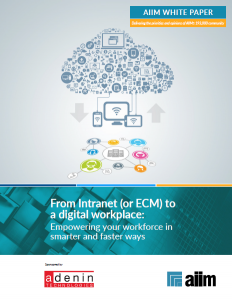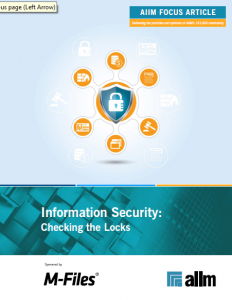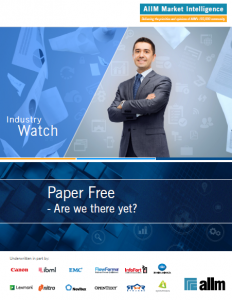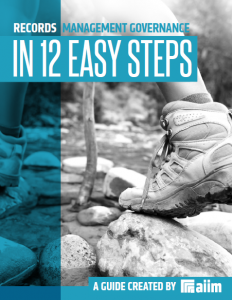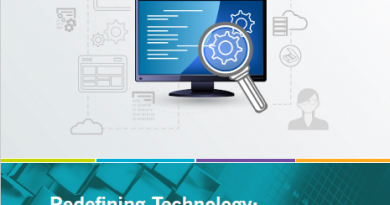AIIM Studien | Winter 2016/17
27. Februar 2017 17:45 Uhr | PROJECT CONSULT Webmaster | Permalink
Der internationale ECM-Dachverband AIIM International hat im Herbst und Winter wieder zahlreiche Studien, Whitepaper, Infografiken und Sammlungen von Tips veröffentlicht. Sie decken ein bereits Spektrum von digitalen Arbeitsplatz über Prozessmanagement bis zu Fragen der Sicherheit ab.
Die kostenfreien Veröffentlichungen der AIIM Association for Image and Information Management sind ein Schatz von Details und Daten zum aktuellen Stand von Enterprise Content Management und Enterprise Information Management. Wöchentlich erscheinen neue Studien der AIIM. In unserem Überblick sind über 20 Dokumente der letzten 4 Monate zusammengestellt. Die Kurz-Links führen dabei auf die AIIM Webseite und auf Dokumentationen bei PROJECT CONSULT. Die Übersicht zu den jeweils aktuellsten Whitepaper auf der AIIM-Webseite findet sich hier: http://bit.ly/AIIMresearch
eBook
- What We Learned from the AIIM Community in 2016
Focus Articles
- For the People: Driving Digital Government with ECM
- SMB: Everything you need to know about ECM
- The Value of Collaborative Manufacturing
Info Graphics
- 6 Shortcuts to Tear Away the Paper
- Using Analytics – Automating Processes and Extracting Knowledge
- The State of Digital Revolution in Government
Industry Whitepaper
- The Agile Enterprise: A Welcome Change
- Puttung the Power of Business Automation into the Hands of Your Business Managers
- Power Your Case Management with Content Analytics
- How To Clean File Shares
- Using Analytics – Automating Processes and Extracting Knowledge
- Revolution or Evolution? 10 Strategies to Navigate the Shift from ECM to Content Services (ebook?)
- How to Achieve Records Management Best Practices
- Information Security: Checking the Locks
- Managing Content Beyond the Corporate Walls: Working in the Cloud
- Paper Free – Are we there yet?
- The Whole Pricture – Using Process Intelligence to Extend Business Intelligence
- Records Management Governance in 12 Easy Steps
- Redefining Technology: The Tool – Not the Goal
- Reducing the Insurance Paper Mountain – An Intelligent Approach to Getting it Right
Tip Sheets:
- 7 Key Changes in Content Management
- 4 Workplace Changes That Should Drive Your Collaboration Strategy
- 5 Reasons Buildung Information Modelling (BIM) is Important
Studien, Whitepaper und Infographics
eBook
|
This paper is a combination of aggregate survey results from the AIIM Industry Watch series conducted throughout 2016, and views and opinions about future trends and directions based on these findings combined with insight gained through AIIM’s interactions with the supplier and consumer communities.
Contents:
- Introduction – Changes In 2016
- Information Management:
- State Of The Industry 2016
- Process Improvement And
- Automation 2016 – A look At BPM
- The Impact Of SharePoint – 2016
- Paper-free 2016 – Are We There Yet?
- Using Analytics – Automating Processes
- Looking At 2017
Keyfindings:
General
- Twenty-seven percent of respondents see content analytics as essential now. Fifty-nine percent see it as essential within the next 5 years.
- Fifty-nine percent of respondents feel that their organization is good (40%) to excellent (9%) at ECM. Fifty-eight percent admit they are poor at using autoclassification.
- Thirty-nine percent of respondents are challenged with poor insight into their business operations. Forty-three percent are addressing challenges related to duplication of content creation.
- Sixty-four percent of respondents see content analytics as a way to improve productivity and remove manual steps. For 62% content analytics is seen as a way of providing business insight.
- For 43% of respondents, data is being captured from security systems (access readers, cameras, etc.) and from facilities equipment (HVAC, lighting, etc.) by 25%. Fifty-one percent of respondents are capturing data from peripheral devices like multi-function copiers, etc.
- Twenty percent of respondents see content analytics as the way to go and are proactively working on it. Fourteen percent see it as useful but no one is currently assigned to investigate it further.
Inbound/Process/Search
- Twenty-five percent of respondents say their processes are flowing faster and more smoothly as a result of using inbound analytics. Fourteen percent cite improved governance and compliance.
- Content analytics is driving autoclassification for tagging and routing to archive by 22% of respondents. Twenty percent indicate they trigger inbound processes based on content analytics used for inbound content.
- When it comes to assigning security and access controls, 25% are using auto-classification for this purpose. 21% are using it for metadata allocation and correction.
- Six percent of respondents utilize contextual search across multiple repositories. For 22% it is simple search across multiple repositories that are still prevailing.
Business Insight
- Sixty-one percent of respondents feel the intelligence derived from content analytics is most useful in providing better insight and decision-making capabilities. Thirtyseven percent feel it is improved product or service quality.
- Fifty-two percent believe automated content curation would be very useful. Eighteen percent indicate they are using it on websites, blogs, and news feeds (3%), subscribed libraries (6%), and internal resources (9%).
- E-discovery with contextual analysis plays a role for 7% of respondents. For 13% e-discovery tools are in place without contextual search capabilities.
- Fourteen percent of respondents use automated analysis on social streams, communities, news feeds, and inbound communications. Automated analysis of helpdesk conversations is in the plans of 15% of respondents.
Application Use
- Thirty-two percent of respondents indicate having more than one content analytics application in place. Fifteen percent say they are currently planning for it.
- When it comes to content types being analyzed, 27% say they have a wide variety across multiple repositories. Twentyone percent say their content is not “big” but they are using complex analytic techniques.
- Regarding linkage to transactions or structured data, 40% of respondents say they have tied their blog content projects to multiple transactional systems. Thirty-two percent say they link to singular systems like ERP, Finance, and HR.
- Return-on-Investment for big content projects has been realized within 12 months for 26% of respondents with 10% of those indicating ROI within 6 months. Forty-four percent are measuring processing times for ROI and 39% reduction in manual processes and activities.
Opinions and Spend
- Forty-two percent will be spending more on inbound workflow automation over the next 12 months. Forty percent of respondents plan to spend more on content analytics for business insight.
Conclusion:
The evolution of information management and process automation has followed a similar path to that of ERP. Initially, individual applications carried out specific information-management and process centric tasks like imaging and capture, records management, content creation, workflow, knowledge management, etc. As users continue to seek out more integrated solutions, vendors offer pre-integrated solutions or partnership packages. Mergers and acquisitions closely follow this shift as the concept of the single-vendor, enterprisewide, modular suite is resurrected. As these suites become more massively capable, they also tend to become more massively complex.
Inevitably, users seek more agile solutions, and niche best-of-breed products regain focus, as they are quicker to take to the technological high ground. Meeting the information-sharing needs of the mobile workforce, social, cloud, and the mobile appification of ECM grows along with the use of hybrid environments combining on-premise solutions with cloud services.
Some users split their information management into three tiers, allocating their legacy systems to handle the robust and compliant records requirements, adding new and agile cloud services for collaboration, and using lighter-weight or industry-specific document, project or case management systems in between. There is, unfortunately, another parallel with ERP, and that is utilization of the available functionality. Despite having invested in systems capable of enterprise-wide collaboration, analytic search, paper-free processes, email governance and strong records management, senior managers seem to lack the will, motivation or awareness to drive through their deployment. As a consequence, many organizations are losing out on huge productivity benefits whilst also leaving themselves exposed to potential compliance and litigation disasters.
Focus Article
|
Good government finds its center of gravity in people. Today, the habits and preferred ways people access government information has changed. There has been a shift from paper to pixels, creating a growing expectation for digital native services, access to content anywhere and at any time, and the ability to access information on any device.
As a result, government agencies worldwide are under increased pressure to digitally transform their key processes, critical operations, and delivery of services to best meet the needs of their citizens. Notably, citizens include not only those who access government services client side, but also government employees who manage these services on the backend.
Contents:
- Getting with the Times
- Enterprise Content Management
- Timing is Everything
- Working Together
- The Full Picture
- Conclusion & Recommendations
Conclusion & Recommendations:
Today’s government agencies must be prepared to undertake a digital transformation to keep pace with the changing consumer landscape: a world where cloud computing, even-smarter mobile devices, and seamless collaboration are commonplace. People comprise the centerpiece to government administrations–both public citizens and public servants—and governments must adapt to most effectively serve their needs. In the United States, on the issue of digital government, President Obama offered the following mission statement: “I want us to ask ourselves every day, how are we using technology to make a real difference in people’s lives.” From the top, agencies must understand and unify their goals, motivations, and vision for attaining a higher standard of digital operations, purging paper-based systems and methods, and creating services expressly for the people. To achieve this, ECM solutions are an effective tool to bridge the digital gap. In this way, we can improve response times, lower costs, enhance collaboration, promote anywhere anytime content access, and heighten visibility of information. To help government work better for the public, and in equal measure, work better for government employees, ECM solutions must be used to their full potential; keep in mind the following best practices
- Assess the needs and requirements of content users as they relate to agency interactions—both internal and external parties.
- Engage the user community for feedback on current paper processes and how future digital strategy may impact their day-to-day activities.
- Investigate options to include cloud and mobile device use wherever possible.
Focus Article
|
If there is one constant in today’s businesses, then that constant is information. No matter if you’re a small business or a multi-national corporation, how an organization manages its information assets is vital to ensure efficient business processes, protect from costly security breaches and compliance issues, and proves a fundamental source of competitive differentiation. Above all, our repositories will be with us for years, and they need to stay relevant.
Contents:
- The SMB Perspective
- ECM on the Horizon
- What You’ll Need
- Identify Requirements
- Define Key Players
- Culture of Participation
- Closing Thoughts and Where to Find Help
Closing Thoughts:
Today’s ECM solutions are lighter, more agile, and affordable, and can be tuned to target specific business operations and problems. No longer costed prohibitively out of reach for SMBs, an ECM deployment could be a very effective way to gain a competitive advantage. As seen in recent polling of the AIIM community, ECM uptake is on course to greatly increase, and it is a worthwhile endeavor to consider. In a number of SMBs, what holds back ECM initiatives is not a problem of ambition, but one of knowledge. Information is the most powerful tool in our arsenal when pursuing an ECM solution; fittingly, we must be well informed first, before we can properly manage information. For this reason, education is a vital part of the equation. If you are unsure of where to begin, seek professional assistance and/or training to help you set off on the right track. Rely on appropriate suppliers and service providers for guidance. Or turn to your professional associations, peers, and community to find advice and training that will teach you best practices.
Remember:
- Assess your organizations unique business requirements. Be fully aware of their nuances to best integrate a complementary ECM system.
- Identify who is in charge early, and at every stage encourage active participation of all stakeholders.
- Never be unwilling to ask for help. Rely on a trusted advisor to answer questions, act as a sounding board, offer past experiences, and help smooth the road to an ECM deployment.
Focus Article
|
To meet the demands of today’s dynamic markets, many organizations are realizing that it is no longer good enough to collaborate exclusively in-house; businesses today must make every effort to work seamlessly alongside external organizations and third parties, or risk falling behind their more social, collectively minded competitors. This is no truer than when we consider the manufacturing industry, which benefits greatly from heightened connection between internal workforce, partners, and customers. In this article, we will take a deep dive into collaborative strategies and technologies as they apply to the manufacturing sector, and discover what opportunities exist for organizations that embrace cooperative efforts, both within their own organizations, as well as beyond the firewall.
Contents:
- Introduction
- A Strong Connection
- Access Anywhere, Anytime
- Bring Your Own Device
- Electronic Forms and PDF
- Conclusion
Cross enterprise document sharing, collaborative content authoring, electronic forms and formats such as PDF technologies, and cloud and mobile device support are all effective ways to streamline tasks in the enterprise and facilitate collaboration. By establishing these types of systems, important data and information can be easily shared between two different organizations—whether it’s a third party vendor or a client—as though they were just another arm of the same enterprise body. To best integrate collaborative efforts into our organization and take fullest advantage of their benefits, keep the following guidelines in mind:
Conclusion:
- Map channels of collaboration in your organization, and assess what’s working well and what is underperforming.
- Seek out employee feedback and discuss collaboration trends in your organization. Find out what their preferred methods of cooperation are, their pain points, what strategies, culture shifts, or technologies they believe would cultivate a better collaborative network.
- Review strategies such as mobile device access or BYOD. Consider possible technology acquisitions to increase collaboration.
- Remove barriers of separation where possible between your organization and customers, vendors, and third parties outside the firewall. This benefits all organizations by possibly shortening time to market, lowering overhead, and increasing efficiency.
Infographic
|
- 47% The human factor – a need to hold something physically – remains the primary reason for continued paper use as reasoned by respondents.
- 65% Demand for paperless communications is somewhat to rapidly increasing for respondents.
38% Respondents say that they now receive more digital invoices than those in paper form. - 44% Speed of data availability is the greatest mobile capture benefit for organizations.
- 47% Lack of management initiatives to move away from paper is believed to be the primary reason for continued paper reliance by organizations
- 38% When it comes to converting key business processes, Accounts Payables (AP) is the top priority according to respondents.
- 20% of respondents are currently or plan to deploy capture in a cloud model in the next 12-1 months
Recommendations:
- Paper free doesn’t happen overnight; keep at it: ROI typically occurs within 6 months as reported by 45% of organizations.
- Technology is a tool, so be tactical. If enterprise wide system suites aren’t for you, consider affordable agile applications to meet your capture and digitization needs.
- People are most important. Aim for usability and quality user-experience.
Infographic
|
- Analytics is Essential: 59% see it as essential within the next 5 years.
- Business Insight is Key: 62% of content analytics is seen as a way of providing business insight
- Education is needed – Extending analytics to the Internet of Things
- 43% of respondents data is being captured from security systems (access readers, cameras, etc.)
- 25% is captured from facilites equipment (HVAC, lighting, etc.)
- Automation is coming: 22% of respondents said Content analytics is driving auto-classification for tagging and routing to archive
- Interoperability is vital: 40% said regarding linkage to transactions or structured data, they have tied their blog content projects to multiple transactional systems.
- Gain the Benefit – Fast payback is a reality
- 26% have realized Return-on-Investment for big content projects within 12 months
- 10% have indicated ROI within 6 monts.
Recommendations:
- Identify a potential business process where analytics is or could be used today.
- Assess where the process slows down, what information is involved, and the sources of that information.
- Identify who is in charge of radical process review in that area, and seek endorsement for policies on analytics use.
Infographic
|
- A Vote for Digital Transformation
- 46% of the Respondents say demand for paperless communications is on the rise
- 19% see a rapid increase in demand
- Visibility is a Top Driver: 75% of respondents report that better monitoring is the biggest expected value granted by content and process management.
- Trusted Partnerships Prove a Valuable Resource: 50% of all responding organizations will expand their content management solution through their current ECM provider.
- There’s an App for that: 76% of respondents agree they need to embrace mobile applications or be left behind
- Looks Good on Paper: 47% say the human factor is still the primary reason for paper use for handling, reading and note taking along with 47% stating a lack of management initiatives to move away from paper
- Closer than you Think – Fast return on Paper-free Ivestment is attainable
- 9% of respondents say paper-free ROI is impossible within 3 monts, while
- 36% indicate payback between 3 and 6 monts.
Recommendations:
- Evaluate how removing paper from operational processes will enhance customer response times, improve the overall customer experience, promote efficiency, and save in back-office costs.
- Investigate options to include cloud and mobile device use wherever possible.
- Digital revolution is about people; technology should make a difference in their lives.
Industry White Paper
|
Today, in the enterprise, nothing is ever at rest; everything is fast, and getting faster. From critical business processes, ECM and capture, to human resource management, marketing, or email— everything seems to be running at a breakneck pace. Work is always working, even if we aren’t. Attempts to keep up with the increasing speed of the enterprise by many organizations have, conversely, slowed things down. This is no truer than when looking at information management in isolation. Notably, these organizations apply the same strategies and deployment architectures to govern their data that would have been used a decade ago.
Contents:
- Introduction
- Integration and Interoperability
- Goodbye Enterprise Software, Hello Apps with K2
- Listen up, executive leaders, IT professionals, software developers and business managers.
- A Look Back
- Cracks Emerge
- A Sea Change for IT
- Enter the Rise of the Business App
- A Smarter App
- Hello, Business Apps with K2
- Build
- Run
- Future-Proof
- Conclusions
- AIIM’s View
Conclusions:
Survival in the age of customer centricit necessitates building, running and futureproofing your business processes in a way that drives efficiency and flexibility. Traditional enterprise software can no longer address these obligations. With apps from K2, businesses can work smarter, increase agility and accelerate growth.
Industry White Paper
|
Increasingly there is demand for business organizations to have structure and visibility into their client facing processes. Considerations must be in place to enhance the overall customer experience and be more agile in their approach to working with and addressing customer needs. This means that the power to make business decisions should be placed in the hands of the business managers, as should the power to change the way the business processes support these business needs. What we are talking about here is the rise of the citizen developer, when it comes to process change and automation. Placing the power to change, in the hands of those who most need it when the need arises. This paper presents the challenges and benefits of placing that power in the hands of the business unit, and how that provides the flexibility, agility, and security business organizations need to increase operational efficiency, and responsiveness.
Contents:
- Introduction
- Business Challenges
- Client engagement
- Contract Management
- Enabling and accelerating innovation
- Conclusions and Recommendations
Conclusions and Recommendations:
Growing demand for more flexibility and agility in business operations requires fundamental changes in where the power is placed to make appropriate changes to the supporting business processes. This means breaking from the traditional method of developing and deploying workflows to a more simplified approach that enables business unit managers to adapt the way they work to meet the immediate need. In essence the organization needs to place the power of change into the hands of the business unit, using simplified technologies and enabling them to become citizen developers. In fact, AIIM research reveals user defined process mapping and modification is the top requirement for 51% of respondents.
Recommendations
- Document a process and where paper enters your business and processes.
- Identify who is in charge of radical process review and seek endorsement for policies on paper-free processes.
- Do not limit your possibilities to be within the corporate walls. Look for ways to extend capture, access and engage activities beyond the corporate walls using mobile and cloud applications.
- Determine where the decision and power to change the process is best managed.
- Provide the technology and training to enable the business unit to design and modify their processes – on their own.
- Promote successes where digital information and processes are being used within your organization.
Industry White Paper
|
Let’s begin with something which isn’t limited to case management and content analytics, yet is a key aspect of a larger discussion – process automation. What does process automation look like today?
- Introduction
- Why Your Customers Care About Case Management and Content Analytics
- Conclusion
Conclusion:
From a technical and regulatory standpoint, complex consumer transactions can happen entirely online. Yet where most mobile strategies miss the point is that as a consumer I want immediate resolution. If you cannot provide that, I will quickly find someone who can. The value you offer to me erodes the longer it takes you to satisfy my desire, and the business value I represent to you drops just as fast, as I am become increasingly likely to move on to your competitor.
Industry White Paper
|
AIIM develops best practices to provide needed guidance for implementing good information management in organizations. File Shares are unique records and information management challenges as they are collaborative in nature, have numerous stakeholders and limited metadata. Management of this environment blends communication, change management and record management principles. This best practice provides more than the theory of managing shared information, it contains the recommendations to conduct a successful file share cleanup project that will improve workflow, remove redundant, outdated and transient information, improve searching capabilities, decrease storage use and support e-Discovery.
Contents:
- Introduction
- Definitions
- Getting Started
- Establish a Project Team and Project Plan
- Identify Dependencies and Assumptions
- Inventory of Information
- Determine Future State and Environment
- File Share Cleaning
- Outcomes
- Lessons Learned
- Recommendations for Creating Standard Operating Procedures
- Training
- ANNEX: Downloading a Sharepoint Directory
- AIIM Best Practice Process
Lessons Learned:
With every project that is undertaken, there are always lessons that are learned along the way. Listed below are some key lessons identified during other organizations’ file share cleanup projects to help you avoid similar issues.
- Get the file structure and policies embedded into the onboarding process.
- In general, people do not have the time to clean up their digital landfills. Find an easy way to bring forward the important information.
- Create a structure on the file share that mimics the retention schedule or file share. Providing the file structure is visually helpful.
- Create a deletion requested or past due retention folder for team members to review prior to deletion.
- Identify a team member to be responsible for a section of a file share, to be the contact for items to go into a shared space. Make sure the team member is empowered to make decisions. Ensure there is accountability.
- A records agent should be responsible for reviewing the materials in the shared area and what is to be deleted.
- Take a snapshot of size and volume before so you can compare the after effect. Watch for team members that delete information to reach deletion goals. Make sure the retention schedule is being followed to ensure that governance rules are met.
- Take care that information being deleted is not part of an active workflow.
- In a large file cleanup, you may be cleaning up files from employees who have left the company. The items to be deleted could be reviewed by the business unit.
- No matter how well planned, information may be deleted that should not have been deleted. Take this risk into consideration.
- Use a DOS command to run a directory of a business unit and put the information to a file, highlight the items based on date to be deleted and run the resulting list by the director to decide for deletion and to the records officer for review to delete.
- Make the file share read only for a limited period of time prior to purging.
Industry White Paper
|
Beyond “big data” style business intelligence, analytics is driving auto-classification, content remediation, security correction, adaptive case management, and process monitoring and modeling. The first step for many analytic processes is capture and recognition – from paper, and from other multiple inbound channels. Something to consider when discussing analytics for process automation and business insight, is that information can and is being captured from multiple sources, including social media, blogs, websites, and even remote devices – the Internet-of-Things. According to 27% of our respondents, content analytics (CA) is seen as essential now, with 59% citing they see it as essential within the next 5 years. Regarding the capture of data from remote devices, 43% of respondents indicate data is being captured from security systems (access readers, cameras, etc.) and from facilities equipment (HVAC, lighting, etc.) by 25%. Additionally, 51% of our respondents are capturing data from peripheral devices like multi-function copiers, etc. In this comprehensive report, we take an in-depth look at the take-up of analytics applications, the success factors and outcomes, integration across repositories, and the issues, benefits and ROI resulting from analytics use. Above all, we look at the progress of organizations moving towards the incorporation of analytics to automate their business processes, and extract valuable customer and business knowledge to enhance their decision-making processes.
Contents:
- Introduction
- Key Findings
- In General
- Drivers
- Use
- Inbound and Processes
- Search
- Business Insight
- Applications
- Options and Spend
- Conclusion and Recommendations
- Appendix 1: Survey Demographics
- Appendix 2: Selective Comments
Keyfindings
General
- Twenty-seven percent of respondents see content analytics as essential now. Fifty-nine percent see it as essential within the next 5 years.
- Fifty-nine percent of respondents feel that their organization is good (40%) to excellent (9%) at ECM. Fifty-eight percent admit they are poor at using auto-classification.
- Thirty-nine percent of respondents are challenged with poor insight into their business operations. Forty-three percent are addressing challenges related to duplication of content creation.
- Sixty-four percent of respondents see content analytics as a way to improve productivity and remove manual steps. For 62% content analytics is seen as a way of providing business insight.
- For 43% of respondents, data is being captured from security systems (access readers, cameras, etc.) and from facilities equipment (HVAC, lighting, etc.) by 25%. Fifty-one percent of respondents are capturing data from peripheral devices like multi-function copiers, etc.
- Twenty percent of respondents see content analytics as the way to go and are proactively working
Inbound/Process/Search
- Twenty-five percent of respondents say their processes are flowing faster and more smoothly as a result of using inbound analytics. Fourteen percent cite improved governance and compliance.
- Content analytics is driving auto-classification for tagging and routing to archive by 22% of respondents. Twenty percent indicate they trigger inbound processes based on content analytics used for inbound content.
- When it comes to assigning security and access controls, 25% are using auto-classification for this purpose. 21% are using it for metadata allocation and correction.
- Six percent of respondents utilize contextual search across multiple repositories. For 22% it is simple search across multiple repositories that are still prevailing.
Business Insight
- Sixty-one percent of respondents feel the intelligence derived from content analytics is most useful in providing better insight and decision-making capabilities. Thirty-seven percent feel it is improved product or service quality.
- Fifty-two percent believe automated content curation would be very useful. Eighteen percent indicate they are using it on websites, blogs, and news feeds (3%), subscribed libraries (6%), and internal resources (9%).
- E-discovery with contextual analysis plays a role for 7% of respondents. For 13% e-discovery tools are in place without contextual search capabilities.
- Fourteen percent of respondents use automated analysis on social streams, communities, news feeds, and inbound communications. Automated analysis of helpdesk conversations is in the plans of 15% of respondents.
Application Use
- Thirty-two percent of respondents indicate having more than one content analytics application in place. Fifteen percent say they are currently planning for it.
- When it comes to content types being analyzed, 27% say they have a wide variety across multiple repositories. Twenty-one percent say their content is not “big” but they are using complex analytic techniques.
- Regarding linkage to transactions or structured data, 40% of respondents say they have tied their blog content projects to multiple transactional systems. Thirty-two percent say they link to singular systems like ERP, Finance, and HR.
- Return-on-Investment for big content projects has been realized within 12 months for 26% of respondents with 10% of those indicating ROI within 6 months. Forty-four percent are measuring processing times for ROI and 39% reduction in manual processes and activities.
Opinions and Spend
- Forty-two percent will be spending more on inbound workflow automation over the next 12 months. Forty percent of respondents plan to spend more on content analytics for business insight.
Conclusion:
The time has come for businesses of all sizes and types to delve deeper into their business operations, gather and analyze more detailed information about their customers, and utilize their information assets more intelligently. This requires planning, focus, and commitment to continuously improve upon what is in place. This requires information and process analytics in ways once dreamed of and today is a reality. It is also a time to view the enterprise more holistically, with an eye on types of information to be collected, where it comes from – the Internet-of-Things – and how it can be used beyond its original intent. For example, the information collected from healthcare devices not only provides data to the Doctor; it can also be used in aggregate to identify patterns or anomalies across patients. In similar fashion, the utility meters provide usage data, but can also serve to identify trends in different regions and can be used to develop and offer new products or services. When it comes to social media, analytics can identify potential issues arising based on customer comments, and also identify shifts in buying patterns. In my view, the time has come to take off the blinders, look beyond traditional boundaries of business content and leverage business information more intelligently. Replication and duplication of information can be eliminated. Information identification, collection, classification, and analytics can be automated to the degree where based on set criteria, business decisions can be made, records managed, and processes initiated, without human oversight. Yes there is an investment to be made, and yes there is expertise required, but this was also true when computers first came into the business world. Our research proves that it is very possible to move an organization forward using analytics to extract knowledge and automate business processes and activities. It also shows that organizations are taking this very seriously with trailblazers proving the theories, additional organizations becoming citizens of the growing analytics community and outlanders quickly realizing they are falling behind and could risk extinction. I encourage you to ask these following recommendations and assess just how your organization can increase knowledge extraction, business insight, and automate processes based on analytics use.
Recommendations
- Identify a potential business process where analytics is or could be used today.
- Assess where the process slows down, what information is involved, and the sources of that information.
- Identify who is in charge of radical process review in that area, and seek endorsement for policies on analytics use.
- Ensure that existing processes are taking full advantage of OCR, data capture and integration with core enterprise systems.
- Position the capture process “right at the door” in order to capture as early in the proces and as close to the first touch point as possible.
- Look beyond the corporate walls and traditional forms of information to include social media, and the Internet-of-Things as primary sources of information.
- Develop a strategy to leverage captured and analyzed information across multiple departments and for multiple purposes. While the data collected from poser meters is used for billing, it can also be used in product development. Security and access readers not only control access activity, the information gathered can be used as a preventative measure to identify potential threats of unauthorized access attempts.
- Establish a continuous improvement program that will periodically review and refine those changes you make now. When a project ends, it should be the beginning of an on-goin process improvement practice that looks for ways to improve upon the foundation you have set and extend those capabilities to other departments within the organization.
- If you are unsure of where to begin or how to begin, seek professional assistance and/or training to help you set off on the right path. Look to your current suppliers and service providers for guidance. Turn to your professional associations and peers to find advice and training that will teach you best practices. It is better to take a step forward and learn, than to take no step and fall behind.
Industry White Paper
|
2016 was certainly a year of radical change. At the macro political level, we witnessed the “ouster of the incumbents” with first the Brexit vote in June and then the U.S. Presidential election in November. In the sports arena, the insurgents triumphed and two teams with a collective 176 years of frustrated championship expectations battled for the World Series. PokemonGo swept the world and led to a host of injuries when enthusiastic participants careened into each other and into stationary objects whilst staring at their screens. Alexa Echo Dots began appearing on every imaginable surface, listening… listening…listening. And perhaps because of the need to be silent in the face of all of this listening, silent Mannequin Challenges became all the rage
Contents:
- A Year Of Radical Change
- Three Constant Reference Points
- New Challenges Facing End Users And Solution Providers
- Actions That Should Be On Your List For 2017
Actions that Should be on your List for 2017? 10 Suggestions:
- Resist the impulse to simply throw the baby out with the bathwater –
Where do you want to rip and replace and where do you want to leave things alone? How do you leverage your existing ECM investments? How do you allow existing missioncritical legacy systems to continue AND invest in new customercentric initiatives? Most organizations have many more systems and repositories than they think. Understand the purpose of each major content system, how current it is, its cost, and whether there are opportunities to consolidate suppliers. As you consolidate, keep in mind the core functional requirements listed above. - Help your organization connect the dots – As the line shifts from technology buyers to business buyers, whom do you need to convince of the merit of your project? Who has funds to pay for your initiative? What kinds of internal capabilities must you have in place in order to be successful? What kind of vendor(s) do you need in order to get this job done? C-level executives are scared to death about disruptive competitors and are demanding new business transformation and customer experience initiatives. Many do not understand that there are often existing technologies and staff competencies in their organization that they equate with their legacy Systems of Record that are directly relevant to challenges created by the needs for Systems of Understanding. Help C-level executives understand these connections, and refocus existing document and content “practitioners” around the challenges and opportunities created by Digital Transformation.
- Give up on the idea that one size fits all – There are a wide variety of content solutions in the marketplace, doing everything from basic back-end process automation at scale to providing a sharing platform for knowledge workers to fueling an integrated and innovative data/content customer journey across multiple sub-processes (like procure to pay, for example, or new customer origination and fulfillment). Understand that the point from which you are starting will likely determine a lot about how far you can go in the next 12 months, and be realistic.
- Understand the importance of metadata – Metadata is the key to moving from a content storage mindset to a content services framework. It is also key to building some element of sanity around both the ability of your knowledge workers to find information across multiple repositories and your ability as an organization to put some framework around the management of content assets. The days of imagining that everything would wind up in a single repository are over.
- Adopt a day-forward mindset – The information management challenge facing most organizations is akin to a leaky boat filling more quickly than the people in the boat can bail out the boat. Are you better served by adopting point solutions to deal with legacy information, and focus your efforts on day-forward initiatives? Do you understand that when information variety and volumes are growing geometrically, a preoccupation with legacy data and information will mean we will never get ahead of the problem? Focus on the water coming INTO the boat first.
- Per Dr. Strangelove, stop worrying and learn to love the bomb – Can shifting focus from records management perfection to risk management-driven realities better position your governance initiatives? How do you become more comfortable with the information chaos that is coming? What will it take to create a hybrid cloud/on-prem capability? These are difficult questions. Traditional command and control approaches to these questions will not work in an environment in which the volume of information is increasing geometrically. Organizations need to rethink their strategies, focus on understanding where risk truly lies, develop strategies to manage that risk, and be willing to embrace an element of “chaotic architecture” for the rest.
- Embrace and experiment with new technologies – Every organization must be open to the introduction of new and innovative technologies in order to stay competitive. Rather than prohibit certain technologies, define principles for how technologies are introduced into the work environment and invest in systems to allow you to audit, find problems, and quickly correct. Invest in educating your employees about what kinds of practices are safe and which are not.
- Don’t use Records Management as a proxy for Information Governance – Or the other way around, either. Maintaining the records of the business is one thing. Managing the information assets of the business has an overlap, but it is not the same. Don’t confuse the two.
- Invest in building new data competencies – In the world that is coming, not everyone will need to be a data scientist, but a LOT of employees will need to be data entrepreneurs. In addition, the worlds of data and content are combining/colliding, so invest in building competencies that understand the intersection.
- Stop thinking about ECM as the lead application – The shift to content services means ECM will take a back seat. The focus shifts to applications that leverage content services for specific business purposes. It also shifts to the integration of content services into our existing applications – finally providing the long-promised benefits of ECM without the adoption issues we have struggled with for so long.
Industry White Paper
|
Organizations are faced with the challenge of providing an information environment that supports the agile needs of their growing remote workforce in ways they can securely access vital information and interact with operational processes. AIIM Research found that when it comes to extending the information ecosystem beyond the corporate walls, mobile and cloud support are seen as important for 67% of organizations.
The expectation by the remote workforce is to have the ability to do “real work” regardless of where they are and regardless of device. Accessing information, interacting with processes transparently is critical and must be an integral part of the information and process management strategy in order to get a holistic view of your data. Take customer data for example: Not every system involved with processing customer data may be available on your mobile device, as the related systems may only be available through desktop applications.
In the way a prism separates light into the many elements of the spectrum, the focus for businesses should be on bringing all information elements across the enterprise to the hands of the user. Think of your information sources across the enterprise as the light spectrum, and your goal is to bring this information from their multiple sources, through a focused lens, to a single point in the user’s hand.
This paper presents the operational challenges of supporting a remote workforce, and the benefits of implementing a mobile approach that provides the flexibility, agility, and security business organizations need to increase operational efficiency, and responsiveness.
Contents:
- About the White Paper
- Process used and survey demographics
- About AIIM
- Introduction
- Work In Place
- Work on Every Device
- Plug in to the Information Ecosystem
- Conclusions and Recommendations
- Recommendations
- Underwritten by
Conclusions & Recommendations:
Business organizations today must deal with the reality that the remote workforce is growing rapidly, mobile device use is increasing, and customer demands for device agnostic access to information is a requirement that must be met in order to ensure customer satisfaction and growth. As a result, business organizations are challenged to build and extend their information ecosystems in ways that embrace and enable a ‘work where you work’ mentality, supporting 24/7 access and interaction from anywhere, on any device. This means that the wide spectrum of information across the enterprise must be brought into focus through a single lens, with the capability of providing notifications when something of relevance has changed or action is required.
When assessing the needs of the organization, it is best to view information and process through the eyes of the user and consider their perspective and requirements from the outside-in rather then the inside-out.
Recommendations
- Document a process and where paper enters your business and processes.
- Identify who is accessing this information, what information they seek, and what information they require.
- List the sources of this information, where it resides, and evaluate how it can be brought to the user through a single lens.
- Provide the technology and training to enable the workforce, and users of this information in ways that align to their business needs and activities.
- Promote successes within your organization.
Industry White Paper
|
The records management program is a management function within the organization that manages the information assets of the organization. An important perspective is that this is not a new area of management. There has always been the need to manage the organization’s information, similar to the centralized control of human resources and the capital assets of the organization. The need to manage information was not generally appreciated in the past because we had paper-based office work, which was difficult to control, repercussions of not managing information properly were not significant, or widely recognized, and there were not the computer solutions available to allow us to manage our records.
Times have certainly changed!
With the need to manage information and records, and with more and more information being created by electronic means, there are computer solutions that can manage this information. These solutions fall under enterprise content management, electronic records management, and/or email management solutions. With these computer applications, we can address the business drivers identified as the four Cs – compliance, cost, collaboration, and (business) continuity.
Contents:
- Introduction
- How To Ensure Information Governance
- Controlled Vocabulary
- How To Create A Classification Scheme
- How To Develop A Metadata Model
- New Ways Of Working
- Technology
- How To Bring About Change Management
- How To Manage Social Media
- Conclusion
Conclusion:
Information and records are key assets of the organization that need to be managed. This has never been so true than at this time as organizations need to respond to the current business trends of big data, mobility, cloud computing, and social media.
We covered a number of topics in this guide; including “How to” for information governance, creating a classification scheme, developing a metadata model, bringing about change management, and managing social media. We also discussed the critical topics of controlled vocabulary, new ways of working, and technology.
Industry White Paper
|
The current direction of the enterprise is digital transformation. Digitalization promotes an efficient information lifecycle that facilitates access to critical information—wherever and whenever it is needed—in a way that wouldn’t be possible with physical mediums. However, proactive measures need to be taken to mitigate the risk of information security breaches even for organizations who have “gone digital.”
A security breach is a potential threat for all organizations regardless of size or industry. It is critical to assess your organization’s risk for a cyber-attack or a security breach, as well as its ability to protect and defend sensitive information. How prepared is your organization to deal with an information security breach?
Contents:
- Introduction
- Rising Risk
- The State of Information Security at Companies Today
- Vulnerabilities
- Challenges
- Conclusion
Conclusion:
Information security risks must be managed to limit monetary losses, disruption of operations, legal forfeitures, and damages to reputation. While awareness to cyber-attacks and hacking are well understood, significant effort must be directed towards protecting against internal threats to information security. The key to ensuring information security begins with diagnosis. Ask yourself the following questions about your organization:
- How does security in your organization measure up to best practices in information security?
- Where are the zones (departments, software, devices) of highest risk for security breaches in your company?
- Do employees receive adequate training about their role in maintaining information security and its importance in mitigating risk and threats to the company?
- What holds security improvement projects back in your organization
Watch this space for our follow-up installment titled “Information Security: Guard against Disaster,” and learn proactive measures you can take to protect your organization against a security breach.
Industry White Paper
|
Organizations are faced with the challenge of providing a flexible and secure environment supporting the agile needs of their remote workforce, partners, and clients. In fact, AIIM Research found that 30% of respondents are seeing increasing use of unofficial cloud content management and file shares. Only 5% indicated they have an “official” cloud-based option. 19% prevent access to non-approved sites.1 Not only does this create additional information silos – that for the most part are unseen by the business – the also present a risk factor from a security, and compliance view.
In today’s business model, organizations must provide support and flexibility in addressing the needs of a growing mobile workforce, and interactions with external partners, suppliers, and clients. In short, today’s business model must look beyond corporate walls and extend their business processes and access to business information in an effective, and secure manner regardless of device type. In this way, cloud applications can be leveraged to enhance and extend business processes beyond their corporate walls and support the increasing use of mobile devices. This paper presents the challenges and benefits of implementing an integrated cloud solution that provides the flexibility, agility, and security business organizations need to increase operational efficiency, and responsiveness.
Contents:
- Introduction
- Keyfindings
- Access Management
- Information Capture
- Information Practices
- Preparedness
- Strategic Direction
- Conclusions & Recommendations
Keyfindings:
Access Management
- The majority of respondents (82%) cite they are still accessing content from corporate file shares and virtual drives. 74% are accessing their content from a corporate ECM system.
- iPhones (61%), iPads (53%), and Android Smartphones (49%) are the most commonly used mobile devices used for accessing documents. On the desktop, Windows PCs dominate while Macs fall way behind.
- The majority (67%) of respondents are looking at cloud to provide device agnostic access on a 24/7 basis. 51% say they see the driver for cloud as being a way to improve collaboration with 26% citing business continuity as a driver.
Information Capture
- When looking at multi-channel inbound content, 42% of respondents say things are adhoc in their organization and it is a struggle to match their on-premise and cloud content. For 32%, capture and processing of content is done on-premise and then moved to the cloud.
- In an effort to streamline operations, auto classification and workflow are being used to identify and route content to on-premise applications (30%). For 28%, there is a distributed capture network in place that feeds a single process or case file on-premise.
- When asked about the deployment of capture in the cloud, 36% say they have something in place now for documents and 32% for reports. An additional 40% have plans related to capturing documents, reports, and spreadsheets in the cloud.
Information Practices
- Looking at changes in content management practices over the next 5 years, 64% say they will be implementing a hybrid platform of on-premise and cloud. For 14% of respondents, there will be a move to a private hosted cloud.
- Focusing on managing corporate electronic records for meeting compliance requirements, 54% say they use on-premise systems. Use of a hybrid on-premise and cloud platform is the method of choice for 25% of respondents.
Preparedness
- Disparate systems are a challenge for most organizations and 30% of respondents say they are migrating to a single system. For 26%, the method of choice is to use clouds services and for 20% it is File Sync and Share
- The exponential growth of content is being addressed by implementing ECM/RM systems to replace their file shares according to 52% of respondents. Automation of retention policies and deletions is the direction for 35% while 35% indicate they will move to a hybrid model for storage.
Strategic Direction
- Moving to the cloud is on the scope for 54% within the next two years, with 23% of those respondents saying it will happen within 6 months. One quarter indicate they have no plans to move to the cloud at this time.
- Turning focus to capture in the cloud, 44% say this will happen within 2 years with 185 of those respondents citing it will happen within 6 months. At this time, 35% say they have no plans to implement capture in the cloud.
Conclusions & Recommendations:
The need and growing demand for organizations to support information capture and access, and process interaction beyond the corporate walls is clear. Maintaining disparate systems, network drives, and file-shares is proving to be ineffective, and an increasing challenge, especially related to compliance, security, and business continuity. Organizations need look towards consolidating their on premise content management systems and moving content capture, access and business processes to the Cloud, creating a hybrid content management environment with a flexible architecture that manages any type of content regardless of size or platform.
Additionally, the exponential growth of information spanning the enterprise is placing a strain on organizational infrastructures in relation to maintaining ROT information housed in siloed repositories. Not only does this represent a cost factor to maintain, it also represents a risk factor to have it and additional costs to sort through it in times of litigation and audit. This emphasizes the need to implement a means for disposing of ROT information properly. It also emphasizes the benefit of automating the retention and disposition processes in an effort to standardize and establish consistent, defensible practices based on business rules and proper information governance.
It is also evident there is a growing realization that information capture at first touch point is a sound strategy to bring information into the ecosystem in a more efficient, secure and manageable way. This in turn not only makes the information available to access, it also serves as the trigger for various business processes and actions to be taken.
With this in mind, we see that the majority of respondents are moving toward cloud use in some form over the next 2 years for storage and access, and nearly half moving their capture processes there as well. While this may seem a simple task, it requires thorough planning to ensure success and minimize the risk of non-compliance. It also requires consideration of impact to current business processes. In other words, governance over the tools, and methods to be used going forward.
We recommend that you consider the following:
Access Management
Identify content creation sources. Who is creating the content? Who is using the content, and how it is being used? How is it accessed and how does the user community want to access it? Once done, look towards giving your business-users flexible, easy to use, transparent access to content from any device, regardless of type, location or security need, which integrates with multiple business applications and workflows to support a multitude of business processes.
Information Capture
Look at the points of capture and assess how content can be brought into the information ecosystem earlier in a process. Look at ways you can utilize the cloud not only for sharing but also as a content capture entry point for your business processes.
Information Practices
Solicit feedback from the user community regarding how they are using and wish to see cloud-based applications today – authorized or not. Additionally, consider the types of mobile device available to use and develop governance policies and practices to enable their use while also managing your information securely.
Preparedness
Incorporate ways to control access and implement monitoring capabilities to prevent unauthorized access, recording all activities related to business content. Design plans to support business continuity and disaster recovery by moving content to the Cloud in way that on-premise content systems work in tandem with Cloud content systems ensuring that if one system fails the other is not effected to minimize operational disruption.
The growing demand to extend business operations beyond the corporate firewall requires significant changes be made in the content management ecosystem. This means breaking from the traditional on-premise behind the corporate walls environment to more platform and device agnostic systems that work within and beyond the firewall.
Evaluate your organizational strengths and weaknesses, and develop clear business requirements from which you can derive functional and technical requirements that will deliver the desired results and maximize your investment. Prepare to enhance your future content management environment not only by adding cloud as a component, but also consider the use of content analytics and process automation to enhance data extraction, content classification, and automate content management process as well as managing system to system interactions.
Industry White Paper
|
Since the 1980s, we have been hearing about paper-free businesses and the drive to move toward a more digital workplace. At the time, the technology and people were not ready for this transformation. Today, the approach to digitally transform businesses has shifted from a technology first perspective to a more business centric approach, with paper-free processes becoming a focal point and opportunity for many organizations.
Yet despite widespread acceptance that reducing and removing paper is a best practice, we find that only twenty-five percent of our 2016 respondents indicate they run a clear/paper-free environment; the good news is that this figure is up from 18% in last year’s report. Discouragingly, 65% of our respondents say they are still signing on paper, even though there is wide and growing acceptance of digital and eSignature technology. Despite this, and the fact that paper is still a somewhat dominant media in business, we see a 3% increase over the 2015 report, with 40% of our 2016 respondents indicating they have a number of paper-free processes and will do more in the future.
It is obvious that while interest and motivation toward a paper-free business environment is increasing, there is still a long road ahead. The human factor is still the primary reason for paper use in handling, reading, and note taking (47%). While benefits are acknowledged, and interest seems to be growing, there is still a lack of management initiatives to move away from paper (47%). Our respondents also cite a lack of understanding and awareness when it comes to paper-free options (39%), indicating a need for education on how to approach and initiate a paper-free project.
In this comprehensive report, we take an in-depth look at the amount of paper in the office, the impediments to removing it, the take up of digital mailrooms and multi-channel capture, and the increasing exploitation of mobile and cloud. Above all, we look at the progress towards paper-free processes, the triggers and decisionmaking processes, and the issues, benefits and ROI.
Contents:
- About the Research
- Introduction
- Key Findings
Keyfindings:
In General
- Twenty-five percent of 2016 respondents indicate they run a clear/paper-free environment; up from 18% in last year’s report. 65% say they are still signing on paper.
- Forty-three percent of respondents say paper is decreasing in their organizations somewhat (35%) or rapidly (8%). 35% say it is stable.
- A three percent increase is seen over the 2015 report, as forty-percent of 2016 respondents indicate they have a number of paper-free processes and will do more. 14% say they are actively looking at every process.
Capture
- Paper in Human Resources (HR) is decreasing in the areas of recruitment (49%) and employee lifecycle (48%). For 41% it is decreasing in Accounts Payables (AP) and Accounts Receivables (39%).
- The greatest paper reductions are seen in records management by 39% of our respondents, with 34% citing AP – invoice processing. For 27% the greatest reduction is seen with technical documents.
- The human factor is still the primary reason for paper use for handling, reading, and note taking (47%), along with a lack of management initiatives to move away from paper (47%). Our respondents also cite a lack of understanding and awareness when it comes to paper-free options (39%).
- Fifty-six percent of respondents are looking to automate manual processes with document classification. For 30%, there is a move to upgrade their technology.
Inbound Content
- The amount of paper arriving at the door is decreasing somewhat (41%) to rapidly (9%). Digital inbound documents are increasing somewhat (47%) to rapidly (19%).
- Demand for paperless communications is somewhat on the rise for 46% of respondents while 19% are seeing a rapid increase in demand. Thirty-eight percent of respondents say that they now receive more digital invoices than those in paper form.
Digital Mailroom
- Fourteen percent of respondents have a distributed, multi-channel approach across paper and digital content – up slightly over 2015. For 29%, things are adhoc in relation to scanning, which is down slightly over 2015.
- A hybrid approach of centralized and distributed capture is in place for 29% of respondents. 18% cite use of centralized capture with multiple desktop scanners, and an additional 18% cite use of distributed capture at their branch offices.
- Forty-one percent of respondents report better quality in downstream data capture and faster-post-box to in-box times equally. For 37% there are equally fewer operational staff and faster turnaround times for customers. Processes
- Responsibility for radical process review falls on the line-of-business or department head according to 26% of our respondents. It is the top-level executive who is responsible for radical process review in 22% of respondent organizations.
- When it comes to converting key business processes, Accounts Payables (AP) is the top priority according to 30% of respondents. For 27% it is Accounts Receivables (AR) and Records Management—cited equally.
- Dedicated workflow/BPM capabilities are in place for 7% of our respondents – up slightly over 2015. 36% of respondents say they have a combination of paper and digital content in the same workflows.
Triggers
- Mandates from above are the motivating trigger for the first paper-free process according to 48% of respondents. 35% are citing cost savings as the initial trigger for their first paper-free process.
- When it comes to additional initiatives to eliminate paper from business processes, respondents cite regular process reviews, and cost savings equally (50%). Improved responsiveness falls next for 42% of respondents.
Mobile
- Mobile is seen as important and in the planning stages for 32% of our respondents. Thirty-three percent of respondents say they support AP with mobile capture apps.
- The most popular content to capture are images for use as records (28%). Twenty-three percent say they use portable devices to capture documents as images only.
- Twenty-three percent of respondents indicate they use process specific mobile apps. Twenty-seven percent say they are using an ECM supported platform.
- Biggest mobile capture benefit cited by 44% of respondents is the speed of data availability. Thirtythree percent say the biggest issue is bandwidth and security equally.
Cloud
- Forty-three percent of respondents say removal of paper from processes should be a constant objective. Eighteen percent of respondents say they are trying to understand and strategically place cloud use.
- When it comes to outsourced services, 40% of respondents say they plan to use more document process/data capture beyond scanning. Fifty-four percent of respondents envision more of a hybrid cloud and on-premise deployment. Opinions and Spend
- Fifty percent of respondents say they will spend more on workflow and BPM. Forty percent of respondents plan to spend more on electronic forms and data capture applications.
- When it comes to purchasing preferences, 48% will turn towards a vendor direct purchase. Sixteen percent of respondents will turn to a Systems Integrator or Value Added Reseller (15%).
- Key lessons learned are having executive level buy-in (42%) and stakeholder involvement (33%). Key benefits identified are faster customer response (50%), and staff reductions with higher productivity (42%).
- Measurements used by our respondents are benefits to the business (46%), and process cycle times (36%). Payback is possible within 3 months according to 9% of respondents, while 36% indicate payback between 3 and 6 months.
Industry White Paper
|
There is a growing need to pull back the curtain of the enterprise and closely examine critical processes and functions to gain operational intelligence. We do this to make processes more efficient, analyse useful metrics, adjust for bottlenecks, and ultimately improve the business. To meet this goal analytic technologies and specifically, business intelligence tools, have become a mainstay in organizations worldwide.
Business intelligence (BI) tools in a number of organizations work to better quantitate overall business performance, provide insight into what transpires at specific points in time, and enhance organizational visibility with data analysis and trend reporting. Moreover, BI tools and other analytical technologies deliver essential insights to fuel informed business decisions, as well as perform that crucial alchemy turning information chaos into information opportunities. However, BI tools don’t offer a perfect image; there exist blind spots in their coverage. BI tools lack process awareness, and as a result, some events in the business go unseen.
The hard reality is this: to be successful in today’s dynamic business landscape it is no longer good enough to see into our enterprise processes; we must also understand what we’re seeing and take action based on that knowledge. The question is how do we create the proper vantage point to view the whole picture?
In this report, we first take a look at the current perceptions of analytic technologies, the rate of uptake, and the obstructions holding back progress. Then we examine organizational trends in using process intelligence and process analytics to extend business intelligence, and how this heightened visibility is leveraged to provide value to customer communications management (CCM), as well as the enterprise as a whole.
Discover how organizations focus the lens of BI tools with process intelligence to see the whole picture, their future plans and procedures, best practices, and challenges you may face.
Contents:
- Introduction
- Key Findings
- Perceptions
- A Clear Priority
- Progress
- The Road Ahead
- Challenges
- Business Intelligence
- Not the Whole Picture
- The Need for Process Intelligence
- Customer Communications Management
- The Right Message
- Closing Thoughts and Recommendations
Key Findings:
Process Intelligence
- Sixty-four percent of respondents leverage analytics and process improvement majorly to optimize processes, and for 52% the goal is to improve customer experience. 43% hold process automation/inbound routing as top priority.
- When asked to rate importance for the business, 38% view analytics as an essential enterprise capability; CCM mirrors this distinction for 20%. Approximately 32% of respondents see analytics and CCM as “something [the business] definitely needs.”
- Forty-one percent of organizations polled are committed to utilizing and developing analytics. 30% acknowledge the usefulness of analytics, but have yet to designate staff for further investigation.
- In relation to analytics, 27% are investigating possibilities, but concede that progress is slow. 29% describe a lack of upper management attention.
- Eighty-six percent of organizations polled are currently or plan to use analytics to increase efficiency of processes. 47% will use analytics in the future for formal knowledge extraction, and 46% to gain insight into content use.
Customer Communications Management (CCM)
- Questioned about CCM priorities, 65% of organizations are chiefly concerned with improvingcustomer service through targeted engagement. 54% hope to improve worker efficiency andeffectiveness.
- Forty-nine percent of respondents say their primary CCM goal is to help facilitate compliantcommunications and reduce paper and fax communication equally. 44% hope to use CCM todevelop robust document and process auditing capabilities.
- Forty-three percent rate upheld compliance standards in communications to be very important. Integration and migrations prompt neutral reactions for 40% and 38% respectively.
- Personalized communication is rated to be important to very important by 51%. 55% feel the same about electronic signatures related to CCM.
- CCM is currently used to deliver customer bills, statements and financial documents for 42% of respondents. 55% have plans to leverage process analytics and business intelligence tools, integrate customer communication platforms, and for delivery of communications in a secure manner.
Business Insight
- Twenty-eight percent currently analyze incident reports, claims and witness statements, and 23% analyze inbound communications. 47% would like to analyze web-accessible databases and inbound communications (41%).
- Automated analysis for helpdesk/service desk conversations is already in place for 24%. 18% have plans to automate the analysis of media channels/news feeds, and incoming customer communication streams and customer onboarding is on the agenda for 15%.
- The most useful business advantage derived from analytics for 63% is non-compliance detection. 48% believe real time process analysis provides the greatest benefit.
Challenges
- In regard to pain points accompanying analytics projects, 45% are burdened by a lack of expertise in analytics, and 33% feel the barrier of entry (tool and resource investment) to be toohigh. 30% find difficulty connecting to and between repositories and systems.
- Asked about challenges related to CCM initiatives, 35% of respondents are held back by lack of expertise, and 33% are hamstrung by the need for considerable investment in tools and resources. 28% struggle due to undefined or unclear goals.
Closing Thoughts and Recommendations:
Success in business today requires insight and understanding of how our operational processes are running in order to take action for improvement. Monitoring, analytics, business intelligence, data integration, and process intelligence unifies these objectives to create actionable insights, enhancing key business verticals/horizontals, streamlining operations, and benefiting the enterprise at a global level.
The overall feeling in the business community is one receptive to analytics. Thought leaders to end users understand the potential benefits and competitive advantage analytic technologies offer the business, from increased business agility, to more secure compliant processes and business operations, and better informed decision making.
A number of organizations are planning or have already established analytic projects, systems, or activities within their day-to-day operations, creating more visible, adaptable, and efficient processes. Some organizations have experience road blocks, stalls, or delays in their efforts to undertake an analytic project stemming from lack of skills and analytic experience, the high cost of investment, and an absence of senior management support.
There is also an apparent need to not only see within our enterprise operations and processes with analytic tools, but to also fully understand the nuances of what we are seeing. Solutions providing the dual perspective of business intelligence and process intelligence create actionable insights which can be leveraged to improve key business functions. Customer communications management is one such area that is augmented by process analytics, helping to deliver effective, compliant communications.
The takeaway is that process analytics is fast becoming an essential enterprise tool and has the potential to enhance a variety of enterprise horizontals and verticals, as well as holistically improve the enterprise as a whole.
Recommendations
- Look out for these best practices in your organization to enhance enterprise visibility and begin to see the whole picture:
- Audit performance and evaluate the blind spots of your current analytic systems. Can greater process intelligence help to solve operational problems and meet business goals?
- Identify who is in charge early for leading analytic projects, and at every stage encourage active participation of all stakeholders.
- If you lack expertise, seek out a trusted advisor to help.
- Carefully consider what tools, technology, and changes are required to achieve your goals in the analytics space, and approach future expansion with this knowledge in mind.
Industry White Paper
|
Not too long ago, records management was a primary concern for many organizations. A small event in a large organization was the trigger that catapulted records management to a topic that was being discussed in board room everywhere and resulted in numerous regulations being drafted and adopted.
Once the visibility of the initial situation calmed down, records management was quickly returned to its normal place of perceived importance and organizations quit talking about it. While we have not seen any organizations or company executives being fined or sent to prison for their organization’s records management transgressions, that is not cause to let our guard down.
This guide was developed to help you and your organization in your records management endeavors. We have strived to identify the key areas that should be reviewed to help you avoid unfortunate and costly non-compliance issues with your records.
12 Steps:
- Know what you have
- Know what to do with what you have
- Establish a File Plan
- Ensure Regulatory and Legal Compliance
- Ensure Business Continuity
- Protect your information
- Make it easy to find Stuff
- Manage it all
- Make sure your Records stay around
- Get rid of Records before it’s to late
- Train the Team
- Monitor, Audit and Optimize
Conclusion:
Records are an asset that organizations must manage. Records management establishes the practices and guidelines that must be followed to ensure that any record created or used in an organization in the course of normal business activities is maintained properly. As a result of the introduction of the regulations, organizations are more aware of their records and are regarding them as business assets rather than taking them for granted. Now, what we need to do is manage the records more effectively.
Don’t rush your records inventory. It will help you to plan your storage requirements for onsite and archival needs.
Make sure that you involve your legal department along with your records managers, IT department, and line-of-business subject experts to ensure all factors are thoroughly explored as you analyze your records and develop your Records Retention Schedules. When the analysis is completed, it should be reviewed by your organization’s leadership and approved at a high level in the organization.
While it is best to use standards, best practices, and test/metrics that have been vetted through a rigorous process, you should also identify and document those standards, best practices, and test/metrics that you have developed within your organization that are specific to your needs.
One of the standards that you should consider using is ISO 15489-1, Information and documentation – Records management – Part 1: General, which provides guidance on drafting a Records Management Policy.
Industry White Paper
|
The enterprise is constantly looking to one-up itself; there’s always an end state on the horizon, a more efficient process, an update and a reboot paving the way for the future. Today’s ambition takes shape as the digital transformation and the push for the paper free enterprise. These aims include digitization of our information, unclogging business processes, and fostering workflows, automation, and seamless mobile and cloud integration.
When thinking about a paper-free initiative or other organizational improvement plan, there is a misconception that technology—not process or people—is the primary barrier and cost of entry to improving our organizations. A number of us have blind faith in technology as a solution, and in its innate ability to singlehandedly provide our desired end state. The reality is that you can’t buy a paper-free enterprise; technology is a tool—albeit an essential tool—but one that is inextricably linked to the support of people and process to solve business problems and achieve our goals.
Contents
- Introduction
- Investing In the Future
- The Problem with One Size Fits All
- The Right Tool for the Job
- Keep This in Mind
- Closing Thoughts
Closing Thoughts
Technology is not the outcome, but the tool to get us where we want to go. It is critical that organizations understand this, and redefine their goals and expectations of technology solutions to match. In this way to create the paperless enterprise or carry out other enterprise transformations people—not technology— must take center stage and drive progress supported by process and tools.
Industry White Paper
|
While paper may still be seen as king in the Insurance sector, the reality is that we now live in an age where information enters the business organisation in many different ways and in many forms. Referred to as multichannel inbound content, the term content includes paper, but can also include email, office files, electronic forms, and more. It enters organisations through the mailroom, email, and websites. AIIM research finds that 58% of organisations polled describe their inbound content handling as ad-hoc, with 23% having elements of multichannel inbound integration, but only 5% have automated routing to multiple processes.
Beyond the risk of information being misplaced, lost, or misclassified, there is the requirement to properly preserve, manage, and protect client information in ways that ensure the integrity, security, and defensibility of this information. Being described here is the importance of controlling documents, content, processes and data from point of entry into the organisation, though the entire document lifecycle, yet at the same time, making this information available to those who need it, when they need it. This is where proper document management becomes crucial to the insurance industry, in supporting compliance requirements, and achieving business objectives.
Contents
- Introduction
- Supporting the Content Lifecycle
- Maintaining Content Connections
- Automation Advantage
- Conclusions and Recommendations
Conclusions and Recommendations
Insurance organisations today must deal with the reality that business must be transacted at the convenience and location of the customers’ choice, in a digital manner that is secure, accessible, and defensible. Regulatory compliance, customer responsiveness, and operational agility are key to maintaining and growing their customer base. It is also vital for insurers to establish and maintain a solid information ecosystem, based on a strong IG framework that meets or exceeds the regulatory and legal compliance requirements. Defensibility, reliability, accessibility, and consistency delivered by a well-planned and maintained ECM system deliver the results.
When assessing the needs of the organisation, it is best to view information and process through the eyes of the user and consider their perspective and requirements from the outside in rather than the inside out.
Recommendations
- Document a process and pinpoint where information enters your business and processes.
- Identify who is accessing this information, what information they seek, and what information they require.
- List the sources of this information, where it resides, and evaluate how it can be brought to the user through a single lens.
- Provide the technology and training to enable the workforce, and users of this information in ways that align to their business needs and activities.
- Promote successes within your organisation.
John Mancini’s Tip Sheets
Zum Schluss noch ein kurzer Überblick zu ausgewählten „AIIM Tip Sheets„, die AIIM Mitgliedern auf der AIIM-Webseite ebenfalls im kostenfreien Download zur Verfügung stehen (http://bit.ly/JM-TipSheets)
• 7 Key Changes in Content Management
• 4 Workplace Changes That Should Drive Your Collaboration Strategy
• 5 Reasons Building Information Modelling (BIM) is Important


